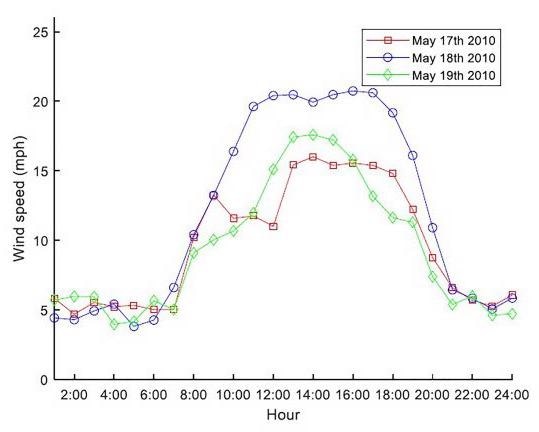Wind energy advancement is widely regarded as an essential way to mitigate greenhouse gas emissions and the effects of climate change. This is because it is not just a renewable energy source but also emissions-free.
 The 24-hour wind speed curve of May 17th–19th, 2010, at Cando. Image Credit: Shuwei Miao.
The 24-hour wind speed curve of May 17th–19th, 2010, at Cando. Image Credit: Shuwei Miao.
This field has seen a lot of progress in recent years with a significant decrease in the cost of developing wind energy, thanks to emerging technologies and incentive policies.
However, wind farms are often located in areas with powerful wind resources and typically consist of several turbines that convert wind into clean electricity, and thus can be made more efficient.
Chinese and U.S. researchers studied diurnal and seasonal patterns of wind speeds and their effect on the adequacy of energy production. The study has been reported in the Journal of Renewable and Sustainable Energy, by AIP Publishing.
In wind farm planning, decision-makers need to select an appropriate site for wind farm installation. We developed a seasonal adequacy assessment procedure using historical wind speed data, wind turbine parameters, system peak load, and other important factors that can help inform decisions on wind farm siting and operation.
Shuwei Miao, Study Co-Author, Three Gorges University
The researchers simulated diurnal and seasonal wind speed variations by using a two-phase simulation model, justifying the accuracy of their results by comparing them with actual data gathered from a wind site in North Dakota. The results enabled them to create the seasonal adequacy assessment procedure.
Wind speed associates with uncertainty along with the season, terrain, and climate. And it also determines the energy production potential. If a power system contains considerable wind farm capacities, then the capability of system generation to meet system load will be heavily influenced by uncertain wind speed. This capability refers to system adequacy, and the quantitative assessment of system adequacy can be helpful to optimal wind farm planning.
Shuwei Miao, Study Co-Author, Three Gorges University
In the first phase of the simulation model, wind speed probability distribution during 24-hour durations was analyzed. The second phase takes wind patterns into account on a seasonal basis. In tandem, they provide major insights into the peculiar subtleties of the naturally occurring energy resource and how to more efficiently leverage them.
We believe our findings are valuable to wind energy development and production. When historical wind speed data, wind turbine parameters, and other data for a candidate site in other regions are available, the model and procedure presented in this study can be readily applicable to simulate the wind profile and assess the seasonal system adequacy indices.
Shuwei Miao, Study Co-Author, Three Gorges University
Journal Reference:
Miao, S., et al. (2021) A two-phase wind speed simulation model considering diurnal and seasonal patterns and its application to adequacy assessment. Journal of Renewable and Sustainable Energy. doi.org/10.1063/5.0059911.